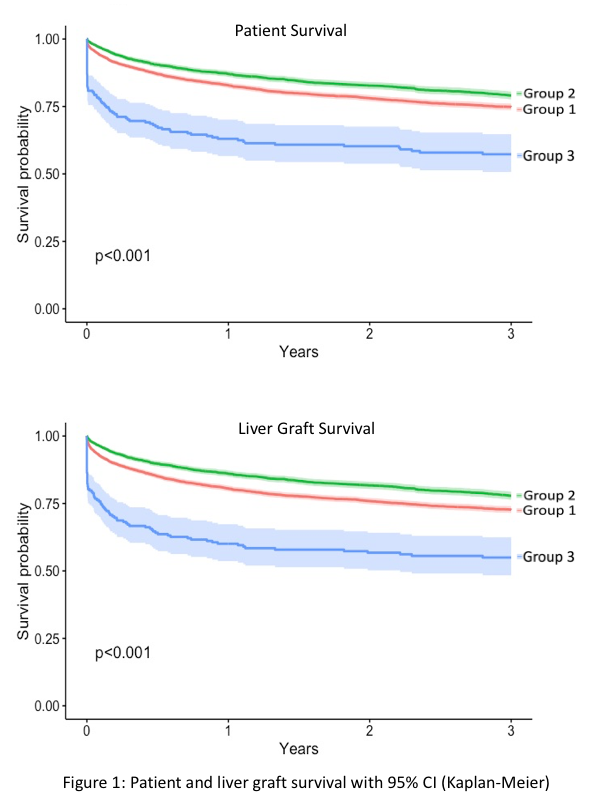Outcomes for Liver Transplant Recipients on Renal Replacement Therapy: Who Cannot Wait for Safety Net
1Department of Surgery, Keck Medical Center of USC, Los Angeles, CA, 2Department of Preventive Medicine, Keck Medical Center of USC, Los Angeles, CA, 3Department of Medicine, Keck Medical Center of USC, Los Angeles, CA
Meeting: 2019 American Transplant Congress
Abstract number: A277
Keywords: Kidney/liver transplantation, Renal dysfunction, Safety, Survival
Session Information
Session Name: Poster Session A: Liver - Kidney Issues in Liver Transplantation
Session Type: Poster Session
Date: Saturday, June 1, 2019
Session Time: 5:30pm-7:30pm
 Presentation Time: 5:30pm-7:30pm
Presentation Time: 5:30pm-7:30pm
Location: Hall C & D
*Purpose: The purpose of this study is to identify risk factors for poor outcomes for liver transplant (LT) recipients on renal replacement therapy (RRT) in order to determine which patients will benefit from simultaneous liver kidney (SLK) transplant as opposed to awaiting a safety net kidney transplant (KT).
*Methods: From 1/1/03 through 12/31/16, 8971 adult primary LT recipients on RRT at the time of LT were identified from the UNOS database. 5359 (59.7%) were listed for and received a liver alone (Group 1). Of 3612 patients listed for SLK, 3414 (38.1%) received SLK (Group 2) and 198 (2.2%) received liver alone (Group 3). One and 3-year patient and graft survival were calculated using Kaplan-Meier method. The association between factors and survival was analyzed using Cox proportional hazards.
*Results: Survival Group 3 had statistically lower patient and graft survival compared to Groups 1 and 2 (p<0.001) (Figure 1). Excluding the 36 of the 198 Group 3 patients who died within 2 days of LT, survival remained significantly lower. Renal Outcome Mean serum creatinine at 3, 6 and 12 months was higher for Group 3 compared to Groups 1 and 2 (p<0.001). Cumulative incidence for KT at 3 years for Group 3 was 7.4% vs. 1.7% and 1% for Groups 1 and 2, respectively. Prognostic factors On multivariate analysis, the factors significantly impacting survival for Group 2 were recipient history of diabetes (p=0.002), MELD score (p = 0.01) and donor KDPI (p = 0.025), while those for Group 3 were recipient age (p <0.001) and days on dialysis (p = 0.001) (Table 1). The number of days on dialysis prior to transplant significantly impacted 1-year patient (p=0.004) and graft survival (p=0.002) in Group 3 while not impacting Group 2.
*Conclusions: Number of days on dialysis (> 90 days) as well as age (> 60 years) are significant for poor outcome for LT recipients on RRT listed for SLK receiving a LT alone; these patients will benefit from SLK.
| Variable | Group 2 | Group 3 | |||
| 3-year patient survival (%) | p-value (multivariable) | 3-year patient survival (%) | p-value (multivariable) | ||
| Recipient Age (years) | ≤ 50 51-60 >60 |
82 77 79 |
0.14 | 65 65 40 |
<0.001 |
| Recipient Diabetes | No Yes |
82 75 |
0.002 | 58 55 |
0.73* |
| MELD | ≤ 35 36-40 >40 |
80 77 76 |
0.010 | 50 72 58 |
0.12* |
| Days on Dialysis | 1-30 31-90 >90 |
79 77 80 |
0.31 | 66 69 40 |
0.001 |
| Donor KDPI (%) | ≤ 50 >50-85 >85 |
82 75 68 |
0.025 | 59 56 56 |
0.96* |
To cite this abstract in AMA style:
Pita A, Kaur N, Lo M, Sabour AF, Tristan V, Genyk Y, Nadim MK, Sher L. Outcomes for Liver Transplant Recipients on Renal Replacement Therapy: Who Cannot Wait for Safety Net [abstract]. Am J Transplant. 2019; 19 (suppl 3). https://atcmeetingabstracts.com/abstract/outcomes-for-liver-transplant-recipients-on-renal-replacement-therapy-who-cannot-wait-for-safety-net/. Accessed December 26, 2025.« Back to 2019 American Transplant Congress

